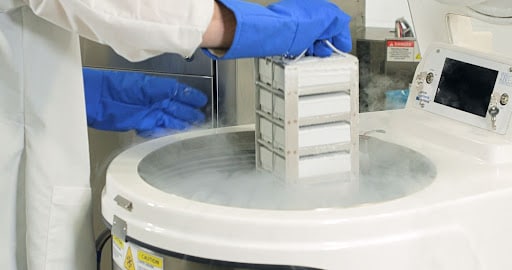Liquid nitrogen (LN2) is used by scientists and research professionals to store and preserve biological materials. Liquid nitrogen is the liquid state of the element nitrogen and is considered a cryogenic liquid, meaning that it reaches below 0℃. Altogether, liquid nitrogen is a vital tool for scientific research.
The Role of Liquid Nitrogen in Cryogenic Storage
Cryogenic sample preservation is a method used to prevent the degradation of biological materials. Below –135 ℃, all biological functions stop, which means that cells and other samples can remain in their present state over long periods.
Liquid nitrogen remains naturally at a cryogenic temperature, with a boiling point of –195.8 ℃ and a freezing point of -210 ℃. The unique, extremely-low temperature range of liquid nitrogen makes it essential to biopreservation and cell research.
Liquid nitrogen can be used to store a variety of organic materials, such as cells, tissues and genetic samples. Because it is effective in rapidly freezing samples, liquid nitrogen allows scientists to store samples long-term and minimizes sample degradation.

The Difference Between Liquid Nitrogen Storage and Ultra-Low Temperature Freezers
Laboratories and biobanks have two options for ultra-low temperature storage: Liquid nitrogen (in either the liquid or vapor phase) or mechanical cryopreservation in the form of an ultra-low temperature (ULT) freezer. Both options are effective methods for storing biological samples, and the best choice will depend on your needs and requirements.
Storage
Mechanical ultra-low freezers are typically powered by a compressor or engine and come in a variety of sizes. The size of the freezer will be determined by the storage capacity and space available in your facility.
Upright ULT freezers, such as the SU780XLE, usually allow for the most storage without taking up a large amount of floor space. ULT freezers operate best when the cold air within is uninterrupted, and storage space is maximized. Sample materials should be well organized to ease retrieval and ensure the shortest time possible that the door remains open.
Liquid nitrogen can be used in both the liquid and vapor form to store biological samples. In the liquid form, samples are submerged directly into the LN2. Advances in technology have allowed for vapor phase nitrogen freezers where samples are stored above the liquid nitrogen rather than directly in it.
The preferred method for long-term storage tends to be liquid phase storage; however, the vapor phase freezers are much more convenient. Many vapor freezers feature a lid that can be opened at the top and a turntable that allows access to the relevant sample rack.
Mechanical freezers are often preferred by researchers who require regular, frequent access to samples, while liquid nitrogen is preferred by those who need longer storage solutions.
Personal Storage Safety Protocols
Ultra-low temperature freezers typically only require gloves as a personal protective equipment (PPE). There are no significant personnel risks or ventilation requirements when handling samples in a ULT freezer.
When working with liquid nitrogen, it is crucial to understand the hazards involved and how to handle the liquid safely. Because it is extremely cold, liquid nitrogen can cause severe frostbite if it comes into contact with living tissue. In addition, adding large quantities of nitrogen to the air reduces the amount of oxygen which may result in asphyxiation.
Therefore, handling liquid nitrogen involves extensive safety precautions. Liquid nitrogen should never be handled without PPE which includes:
- Face shield and unvented chemical splash goggles
- Insulated cryogenic gloves
- Closed toed shoes
- Long sleeved shirt and pants
- Apron made of leather or non-absorbent material
Liquid nitrogen should only be used in well-ventilated areas and stored in containers that can handle extremely low temperatures and will not degrade when in contact with LN2. Handlers should use an insulated container like a Dewar flask.
The liquid should never be stored in a sealed container without a pressure relief device. Due to the expansion ratio from liquid to gas, a build-up of pressure can occur when the liquid nitrogen evaporates. Having a pressure relief device on the container helps to keep the liquid regulated and not cause an explosion.
If you plan to utilize liquid nitrogen for cryogenic storage, implementing standard operating procedures will be crucial for maintaining the lab’s safety.
Temperature Control
The biggest difference between mechanical ULT freezers and liquid nitrogen freezers is the temperature range. Mechanical ULT freezers utilize a refrigerant and have a temperature range from -50℃ to -80℃. They provide a uniform top-to-bottom temperature throughout the storage chamber and are not subject to temperature fluctuations..
Vapor freezers can store samples as low as -150℃. In vapor storage freezers, the liquid nitrogen is usually piped into the lower part of the freezer and the vapor is used to cool the upper racks. This can result in temperature gradients within the unit which has the potential to cause biosample degradation.
Some biorepositories will take advantage of both mechanical freezers and liquid nitrogen freezers as freezing samples too quickly can damage them. Mechanical freezers can be used to gradually lower the temperature of the samples before they are placed in long-term liquid nitrogen storage.
FAQs
Regarding liquid nitrogen and its uses, people also ask:
Why is liquid nitrogen used for storing biological materials?
Liquid nitrogen is used for storing biological materials because it can reach very low temperatures of -196 ℃ and help prevent cell degradation in these materials.
For what purpose is liquid nitrogen used?
Liquid nitrogen is often used for cooling and cryogenic storage at extremely low temperatures.
How can liquid nitrogen be used safely?
Liquid nitrogen should only be handled slowly and carefully and in well-ventilated areas. This also includes using covered and approved containers that can withstand extremely low temperatures.
What hazard class is liquid nitrogen?
Liquid nitrogen is hazard class 2.2 and is considered a non-flammable gas.
For more information on using liquid nitrogen for storing biological materials, contact Stirling Ultra Cold Freezers.